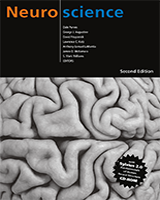By agreement with the publisher, this book is accessible by the search feature, but cannot be browsed.
NCBI Bookshelf. A service of the National Library of Medicine, National Institutes of Health.
Purves D, Augustine GJ, Fitzpatrick D, et al., editors. Neuroscience. 2nd edition. Sunderland (MA): Sinauer Associates; 2001.

Neuroscience. 2nd edition.
Show detailsPainful stimuli are usually associated with tissue damage (e.g., cuts, scrapes, and bruises). The familiar phenomenon of hyperalgesia is defined as the enhanced sensitivity and responsivity to stimulation of the area around the damaged tissue. Thus, in the region surrounding an injury, stimuli that would not normally cause pain are perceived as painful, and stimuli that would ordinarily be painful are significantly more so (therefore, hyperalgesia). The cause of this phenomenon is the sensitization of nociceptors by various substances released when tissue is damaged (Table 10.1). Evidently, the release of bradykinin, histamine, prostaglandins, and other agents from the site of injury enhances the responsiveness of nociceptive endings. Electrical activity in the nociceptors themselves also stimulates the local release of chemical substances (such as substance P) that cause vasodilation, swelling, and the release of histamine from mast cells. Injury and pain are thus intertwined in a complex cascade of local signals. The involvement of these substances in the production of pain has also provided clues about how some analgesics may work, suggesting strategies for pain relief. Aspirin (salicylic acid), for example, evidently acts by inhibiting cyclooxygenase, an enzyme important in the biosynthesis of prostaglandins.
Table 10.1
Substances Released Following Tissue Damage.
The presumed purpose of the complex chemical signaling arising from local damage is not only to protect the injured area (as a result of the painful perceptions produced by ordinary stimuli close to the site of damage), but also to promote healing and guard against infection by means of local effects such as increased blood flow and inflammation.
- Hyperalgesia and Sensitization - NeuroscienceHyperalgesia and Sensitization - Neuroscience
Your browsing activity is empty.
Activity recording is turned off.
See more...